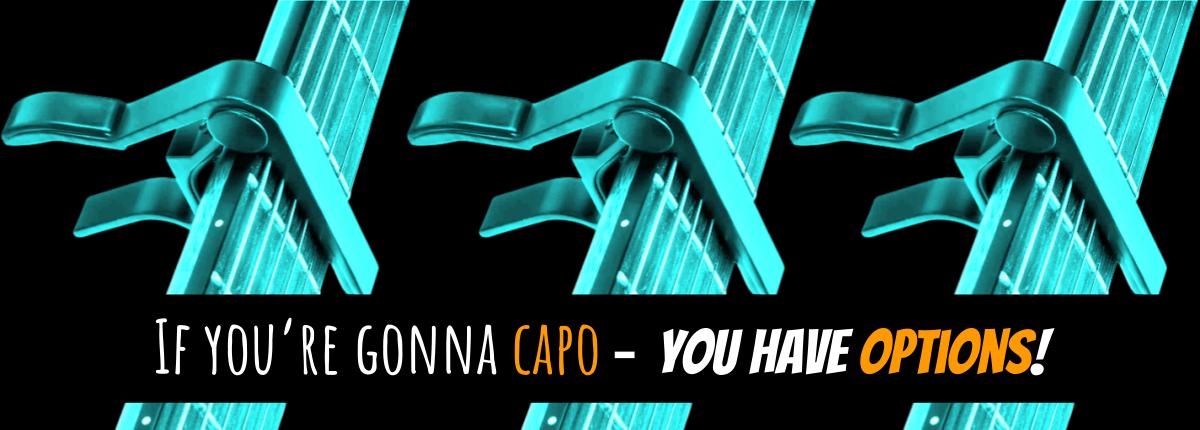
By Matt Gose
Posted 06/28/2022
The guitar is an incredibly versatile instrument, filled with nearly limitless potential. To unlock the full breadth of your guitar’s capabilities, however, a few basic tools may be required. Perhaps no tool is more essential than the ubiquitous capo. These small but powerful gadgets allow you to transpose on the fly, discover new voicings to your favorite chords, and even open up new tuning possibilities.
Finding the right capo, however, can become quite the quest.
Today we’ll break down some of the most popular capo styles so that you can discover which ones best suit your tones and techniques.
Trigger Capos
Being the simplest, cheapest, and most widely used capo variety, these bad boys are an excellent place to start. These versatile tone tools rely on the same mind-blowing principles as the chip-clip — utilizing a spring-loaded clamp that applies pressure across your guitar’s fretboard.
Simply squeeze to open the clamp and shift it over the desired fret.
Pros
- Cheap
- Easy to place and remove quickly, making them ideal for live settings
- Long-lasting
Cons
- Weak, uneven pressure allows for fret buzz
- Angle places tension on one side of the fretboard before the other, contributing to potential intonation issues
- Loose attachment — making them susceptible to being bumped out of place while you’re rocking out
Screw Capos
This variety is a notch up from Trigger Capos. An adjustable screw mechanism allows you to adjust the pressure on your guitar’s neck to the desired level.
Pros
- Even pressure keeps your strings more in tune
- Achieves perfect tension for a variety of neck shapes, styles, and sizes
- Stays put better than clamp capos
- Relatively inexpensive
Cons
- Repositioning takes more time than trigger capos
Yoke Capos
Yoke capos are essentially screw capos that completely wrap around the neck of your guitar, with the screw placed dead center, allowing for more accurate and even distribution of pressure. These capos usually feature a hinged arm that clips down over the frets.
Pros
- Adjustable, evenly placed pressure
Cons
- Requires even more work to put on and adjust than other varieties; not great for live settings
Roller Capos
While not as popular as their cousins, Roller capos are in some ways the most versatile variety. These odd little buggers clamp over your guitar and screw into position over the frets. What makes them unique, though, is that instead of remaining stationary like other styles, they can roll across your fretboard to different positions, allowing you, in theory, to move your capo up and down between or even within songs, simply by pushing them with your thumb.
Pros
- Fast repositioning
- Effortless removal – just slide it over the nut for open-string playing
- Wider fretting pressure – helps keep strings evenly in tune
Cons
- Non-adjustable tension — can lead to fret buzzing
- Narrow width — makes it difficult to use for 12-string or classical guitars
- Can roll out of place, causing you to slip out of tune from the rest of the band
Strap Capos
Another popular and relatively simple model, Strap capos are just that, an elastic strap with a padded bar attached. The straps usually include a simple ratchet so that you can adjust the tightness as needed.
Pros
- Easy to use
- Slides up and down the neck with ease
- Inexpensive
Cons
- Straps wear out quickly — especially ones made of synthetic material
- Can slip out of position easily
Toggle Capos
Toggle capos are the metal-studded, punk rock sibling of the strap capo. While they too feature a strap, they adjust along several metal notches located on the back of the fret bar.
Pros
- Small, light, inconspicuous.
- Inexpensive
- Adjustable tension
Cons
- Finding the ideal tension between notches can be a bit of a hassle
- Tension will loosen over time
C-Clamp Capos
At first glance, this style looks similar to the simple trigger capo, with subtle differences — but oh, what a difference those differences can make! Combining the ease of use of trigger capos with the adjustable tension of screw capos, C-clamps offer the best of both worlds. Their unique features, like a rubber contact surface, eliminate many of the tonal issues caused by other capo styles. These features, however, do come at a cost.
Pros
- Easy to take on and off
- Provides adjustable tension
- Preserves tuning and tone
Cons
- Among the most expensive capo varieties
Partial Capos
This capo style is exactly as it sounds — a capo with a shortened fret bar. This allows you to clamp down certain frets while leaving others open, increasing tonal possibilities exponentially. While this may seem advanced, the truth is, partial capos can inspire experimentation even for novice players. Experiment with a combination of full and partial capos and escape into an eternity of sweet possibilities.
There’s not much else to say about this style. They can come in a variety of clamp styles, but in general, they work essentially the same way as their full-fret counterparts.
Get a Grip
Whether you’re a singer needing to alter a song’s key on the fly, a picking wizard looking to find new chord possibilities, or simply a tone traveler looking to add to your sound and style, a capo will quickly become your best friend. Choosing the right style depends on your guitar as well as your unique voice and technique. Experiment with different capo styles to find the one that best suits you, or keep a few on hand for both live and studio settings.
